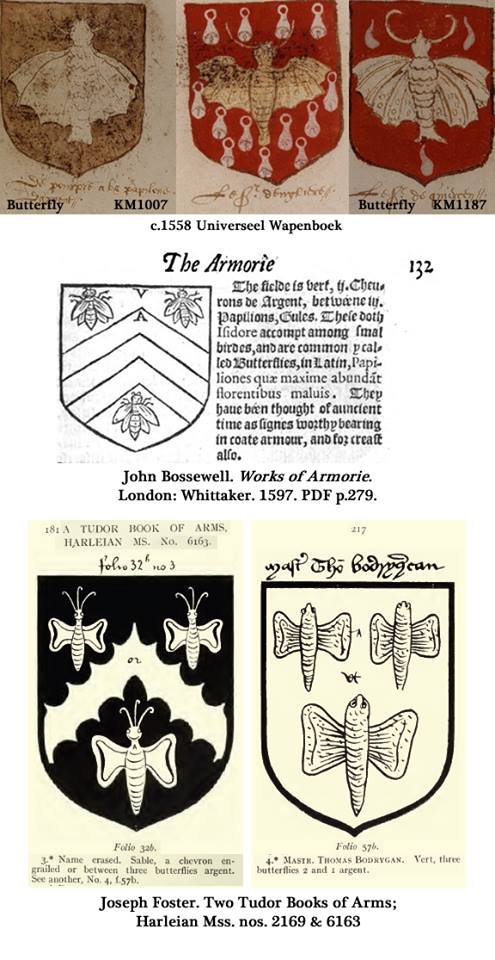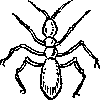Insect, Arthropod
WARNING: Do not cite this page as a reference. This page is on this wikispace only to make the content "searchable" and easier to find. If you find the information you seek here, go to the original sources to verify the information and use them for your documentation.
Illustrations:[edit | edit source]
Period sources:[edit | edit source]
Bugs in pre-17th c. Heraldry[edit | edit source]
Butterflies:[edit | edit source]
File:TudorBanner butterflies.jpg Banners, Standards and Badges, Tudor manuscript, butterflies and a moor's head
Winged ants:[edit | edit source]
16th 16th century Italian, winged ants
Butterflies:[edit | edit source]

|
Miscellaneous butterflies, courtesy of Gunnvor silfrahar |
Praying Mantis:[edit | edit source]
| http://britishlibrary.typepad.co.uk/.a/6a00d8341c464853ef01a511fa6806970c-800wi | Additional MS 28841, f. 6r, 14th C image, praying mantis and other bugs
http://britishlibrary.typepad.co.uk/digitisedmanuscripts/2014/08/bugs-in-books.html |
_Mantis religiosa_ is native to Europe.
Modern Sources:[edit | edit source]
Pictorial Dictionary 3rd Edition:[edit | edit source]
Pennsic Traceable Art Project:[edit | edit source]
[edit | edit source]
Sources:[edit | edit source]
- Academy of St. Gabriel "Medieval Heraldry Archive" - http://www.s-gabriel.org/heraldry/
- Archive of St. Gabriel reports - http://www.panix.com/~gabriel/public-bin/archive.cgi
- Laurel Armory Articles - http://heraldry.sca.org/laurel/armory_articles.html
- New Heraldic Primer (Heraldry for Non-Heralds) - http://heraldry.sca.org/armory/newprimer/
- Pictorial Dictionary of Heraldry (PicDic), 3rd Edition - http://mistholme.com/pictorial-dictionary-of-heraldry
- Period Armorials
- Parker's Heraldry - http://karlwilcox.com/parker/
- Riestap's Armorial Général - http://www.euraldic.com/lasu/bl/bl_a_aa.html
A Heraldic Primer: ... Insects[edit | edit source]
http://heraldry.sca.org/primer/reptiles.html (defunct)
Insects and arthropods can be found in armory. All insects are found depicted in the tergiant posture. However, when the insect is winged, the posture is known as volant en arrière (flying).
 ]] ]] |
 ]] ]] |
 ]] ]]
|

|
| a bee volant | a butterfly volant | an emmet (or ant) tergiant | a spider tergiant |
SENA[edit | edit source]
Appendix L: A Partial List of Postures and Orientations[edit | edit source]
This is a list of postures and orientations that can be used to determine whether two charges or groups of charges conflict or whether there is a distinct change for posture/orientation.
Animate Charges[edit | edit source]
C. Insects and Other Tergiant-Default Creatures: This category is for insects and other creatures whose default is tergiant. The postures listed within each group generally conflict.
- tergiant
- tergiant inverted
- bendwise
- bendwise sinister
http://heraldry.sca.org/sena.html#AppendixL (as of July 2019)
Precedents:[edit | edit source]
Precedents of the SCA College of Arms - http://heraldry.sca.org/laurel/precedents.html
Morsulus Heralds Website - http://www.morsulus.org/ (to search the LoARs and Precedents)
Use the above links to be sure any precedents listed below haven't been superseded by newer precedents.
Definition:[edit | edit source]
(includes defaults, proper tinctures, blazoning)
Example[edit | edit source]
Registerability:[edit | edit source]
(Restricted, Reserved, SFPP, OOP)
July 2007 - spiderwebs:[edit | edit source]
Gafanko Popovich. Per bend sinister azure and gules, a bend sinister and in dexter chief a spider web throughout argent. Spiderwebs are at least gray period, but as used here they have been ruled a step from period practice (v. Victoria of Cúm an Iolair, 03/2005):
- While spiderwebs are described in Guillim's Display of Heraldry, 1632, the only known examples show the spiderweb alone and covering the entire field. Using the spiderweb on only half the field is thus a step from period practice.
http://heraldry.sca.org/loar/2007/07/07-07lar.html
October 2002 - rising:[edit | edit source]
"Rising is not a defined posture for insects." [October 2002 LoAR]
Oct 2002 - statant palewise:[edit | edit source]
"Note that the SCA accepts bees in a statant posture (horizontal body, legs down, wings addorsed). The SCA also accepts bees which are statant in a clearly defined bendwise or bendwise sinister posture. However, it is not acceptable to rotate a statant bee 90 degrees to a "palewise" posture. The resulting posture, with a vertical body, and legs extended to dexter, is equivalent to the previously forbidden "rampant" posture for bees and similar insects." [October 2002 LoAR]
Aug 2002 - insects statant:[edit | edit source]
"The SCA has registered many insects statant, as well as other arthropods statant (such as scorpions), even when the insect or arthropod has only been documented as tergiant in period heraldry. Without an extensive change in policy concerning the acceptability of insects or arthropods statant, this may be registered." [August 2002 LoAR]
May 2002 - inverted animate charges SFPP:[edit | edit source]
"The SCA has general precedents against registering inverted animate charges unless they are part of a radially symmetrical group such as in annulo. These precedents are on the grounds that such inverted animals are generally not readily identifiable, and they are not found in period heraldry. However, the SCA also has a registration tradition of allowing animals which are usually found in a tergiant posture to be registered in the tergiant inverted posture. " "There is very little period evidence for tergiant inverted animals in heraldry." "As a result, inverting a tergiant charge is acceptable as long as it does not otherwise violate any basic heraldic principles, including the requirement for identifiability. Because of the lack of period evidence for tergiant inverted charges, the posture will be considered a clear step from period practice (also known informally as a "weirdness") for any charge that cannot be found in this posture in period." [May 2002 LoAR]
April 2001 LoAR - insects rampant unregisterable:[edit | edit source]
Robert Pine. Device. Azure, two wasps combattant, a bordure argent. (R-Atlantia) "Long precedent has held that non-quadrupeds cannot be registered in positions such as rampant. In particular, in May 1991, Laurel stated "Henceforth, we will not accept rampant birds." In the same month, Laurel said, "given the College's feelings about birds in a rampant position it is unlikely that a rampant insect would be any more acceptable." Since that time, we have not registered insects in a rampant position, and see no reason to do so now."
May 1983 - insect-winged monsters unregisterable:[edit | edit source]
Caterina Leonora de Forza. Return of: Vert, a Bengal tiger couchant guardant to sinister with Tiger Swallowtail butterfly wings elevated and addorsed proper within a bordure Or. "The device is not period style. To my knowledge, the only wings added to beasts in period were those of bats or hawks..."
Conflict:[edit | edit source]
April 2008 - bee vs fly:[edit | edit source]
[a bee vs. a fly] ... but nothing for changing the type of insect. [Hannibal Beman, [04/2008,] R-Ansteorra]
Dec 2002 - tergiant fesswise vs. statant:[edit | edit source]
"There is a CD between a bee tergiant fesswise and a bee statant. Both postures show the bees with fesswise bodies, but a bee tergiant fesswise has wings visible on both sides of the bee's body, while a bee statant only has wings visible on the chiefmost side of the body. This difference is worth a CD, analogous to the difference between a bird rising wings displayed and a bird rising wings addorsed." [2002 LoAR]
Sept 2001 - bee vs. dragonfly:[edit | edit source]
"When drawn clearly, there is a CD between a bee and a dragonfly." [September 2001 LoAR]
Identifiability:>[edit | edit source]
Collected Precedents:[edit | edit source]
- 2nd Tenure of Elisabeth de Rossignol (April - August 2011) - [ARTHROPOD - Lobster], ARTHROPOD - Scorpion see [ARTHROPOD - Lobster]
- 1st Tenure of Elisabeth de Rossignol (May 2005 - July 2008) - [ARTHROPOD - Ant], [ARTHROPOD - Bee], [ARTHROPOD - Beetle], [ARTHROPOD - Butterfly], ARTHROPOD - Crab see [ARTHROPOD - Lobster], ARTHROPOD - Dragonfly see [ARTHROPOD - Butterfly], ARTHROPOD - Fly see [ARTHROPOD - Bee], [ARTHROPOD - Lobster], ARTHROPOD - Scarab see [ARTHROPOD - Beetle], ARTHROPOD - Scorpion see [ARTHROPOD - Lobster]
- The 2nd Tenure of François la Flamme (October 2004 - May 2005) - BUTTERFLY see [ARTHROPOD -- Miscellaneous], [ARTHROPOD -- Miscellaneous]
- The Tenure of Shauna of Carrick Point (May 2004 - August 2004) - [Arthropod], [Bee], [Spider]
- The 1st Tenure of François la Flamme (August 2001 - April 2004) - http//heraldry.sca.org/precedents/francois/wreath.html#BEE ARTHROPOD -- Bee, [ARTHROPOD -- Miscellaneous], [ARTHROPOD -- Spider]
- The Tenure of Elsbeth Anne Roth (June 1999 - July 2001) - Collected Armory Precedents
- The Tenure of Jaelle of Armida (June 1996 - June 1999) - Single HTML Document
- 2nd Tenure of Da'ud ibn Auda (November 1993 - June 1996) -
- The Tenure of Bruce Draconarius of Mistholme (June 1992 - October 1993) - [ARACHNID -- Scorpion], [ARACHNID -- Spider]
- 1st Tenure of Da'ud ibn Auda (June 1990 - June 1992) -
- The Tenure of Alisoun MacCoul of Elphane (September 1986 - June 1990) - [Arachnid - Scorpion]
- The Tenure of Baldwin of Erebor (August 1984 - August 1986) - Single HTML Document
- The Tenure of Wilhelm von Schlüssel (August 1979 - August 1984) - [BUTTERFLY]
- The Tenure of Karina of the Far West (December 1975 - June 1979) - Collected Precedents
- The Early Days (June 1971 - June 1975) - [BUTTERFLY]
In the Ordinary[edit | edit source]
(includes crustacean)
- [Arthropod - Ant] (includes emmet)
- [Arthropod - Bee] (includes honeybee)
- [Arthropod - Beetle]
- Arthropod - Butterfly - see [Arthropod - Moth]
- Arthropod - Cockroach - see [Arthropod - Beetle]
- Arthropod - Crab - see [Arthropod - Lobster]
- Arthropod - Crawfish - see [Arthropod - Lobster]
- [Arthropod - Dragonfly] (includes mosquito)
- Arthropod - Earwig - see [Arthropod - Beetle]
- Arthropod - Grasshopper - see [Arthropod - Mantis]
- Arthropod - Hornet - see [Arthropod - Bee]
- Arthropod - Ladybug - see [Arthropod - Beetle]
- [Arthropod - Lobster]
- [Arthropod - Mantis]
- Arthropod - Mosquito - see [Arthropod - Dragonfly]
- [Arthropod - Moth] (includes butterfly, papillion)
- Arthropod - Roach - see [Arthropod - Beetle]
- Arthropod - Scarab - see [Arthropod - Beetle]
- [Arthropod - Scorpion]
- Arthropod - Shrimp - see [Arthropod - Lobster]
- [Arthropod - Spider] (includes arachnid)
- Arthropod - Wasp - see [Arthropod - Bee]